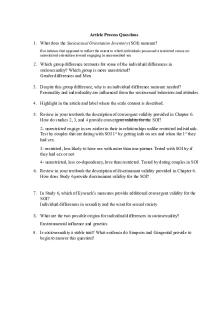Gladwell Chapters Process Questions PDF

| Title | Gladwell Chapters Process Questions |
|---|---|
| Author | Cori Johnson |
| Course | Psychological Testing |
| Institution | California State University San Marcos |
| Pages | 1 |
| File Size | 78.2 KB |
| File Type | |
| Total Downloads | 70 |
| Total Views | 146 |
Summary
Download Gladwell Chapters Process Questions PDF
Description
Article Process Questions Gladwell, M. (2008). Outliers: The Story of Success. New York, NY: Little, Brown and Company.
By the end of reading the chapter, you should be able to answer the following questions: 1. What was the IQ range of Lewis Terman’s “Termites”? What did Treman predict about this group of gifted children? a. IQ range was 140; he predicted the group was a heroic stature; future elite 2. What does the Raven’s Progressive Matrices measure? Does the test measure schoolbased learning? a. It measures IQ; does no test school based learning just intelligence 3. Beyond which IQ score do additional IQ points not predict real-world success? What are some of the things that might matter for success beyond this point? a. Over IQ of 120 is the cut off; someone that is an IQ of 170 needs just as much help as someone with an IQ of 70. Most nobel prize scientist have really high IQ 4. Which intelligence did Robert Sternberg possess that Chris Langan lacked? Which of the two broad types of intelligence is best measured by IQ testing? a. He lacked practical intelligence; analytical 5. What are the two types of parenting styles discussed by Lareau? Which one is predictive of success in our culture? a. Two parenting styles were divided by wealthier (more involved and child was in more activities) and poorer classes (no sports, but made up games at home, no routine/ schedule) b. The middle-class parents; cultivation to foster and assess a childs talents, opinions and skills. 6. What turned out to be the best predictor of how the Termites performed in adulthood? a. The A group was classified to be in the upper SES and was able to achieve more than the C group; Terman concluded that you need a proper community 7. Why do Asian children learn to count much faster than American children? a. Our eleven is their ten-one, twelve to ten-two 8. What happens if you compare the math rankings on the TIMMSS to the questionnaire rankings? What skill tied to success does this finding demonstrate? a. They are the same; meaning the same countries students can focus and answer all the questions on the questionnaire. These students are best at solving math problems 9. According to Alexander’s study on the achievement gap, why do children in poor households underperform when compared to children in wealthy households? a. 10. What is the goal of KIPP Academy?...
Similar Free PDFs

Fuera de serie-Malcolm Gladwell
- 176 Pages

Gladwell How David Beats Goliath
- 13 Pages

Questions Chapters 7-12 E-Connect
- 24 Pages

exam one questions chapters 1-12
- 4 Pages

Chapters 2,3,4,6,7,12,13
- 12 Pages

Chapters 1516
- 6 Pages
Popular Institutions
- Tinajero National High School - Annex
- Politeknik Caltex Riau
- Yokohama City University
- SGT University
- University of Al-Qadisiyah
- Divine Word College of Vigan
- Techniek College Rotterdam
- Universidade de Santiago
- Universiti Teknologi MARA Cawangan Johor Kampus Pasir Gudang
- Poltekkes Kemenkes Yogyakarta
- Baguio City National High School
- Colegio san marcos
- preparatoria uno
- Centro de Bachillerato Tecnológico Industrial y de Servicios No. 107
- Dalian Maritime University
- Quang Trung Secondary School
- Colegio Tecnológico en Informática
- Corporación Regional de Educación Superior
- Grupo CEDVA
- Dar Al Uloom University
- Centro de Estudios Preuniversitarios de la Universidad Nacional de Ingeniería
- 上智大学
- Aakash International School, Nuna Majara
- San Felipe Neri Catholic School
- Kang Chiao International School - New Taipei City
- Misamis Occidental National High School
- Institución Educativa Escuela Normal Juan Ladrilleros
- Kolehiyo ng Pantukan
- Batanes State College
- Instituto Continental
- Sekolah Menengah Kejuruan Kesehatan Kaltara (Tarakan)
- Colegio de La Inmaculada Concepcion - Cebu









